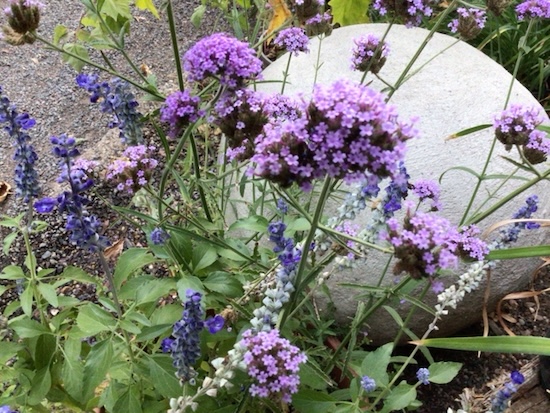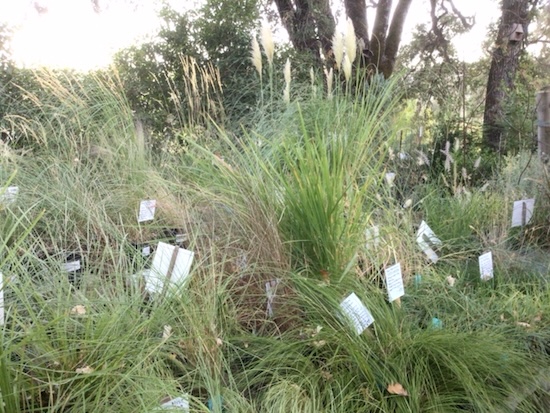
I have just returned from a road trip with my son to see our family in Lethbridge, Alberta, via White Salmon, Washington. My other son and his family live in White Salmon, so a few days spent there on the way and on the way back from Canada broke up the trip. We spent one-night camping in the mountains near Waterton/ Glacier on the Blood Timber Reserve. My family there are members of the Blood clan of the Blackfoot Nation. The meadow we camped in was loaded with diverse flora, and I was pretty impressed with all the things I identified. Probably most prominent by sheer size and the fact that it blooms all season was yellow Potentilla, aka Cinquefoil. You see hybrids of this deciduous shrub planted in landscapes in higher elevations. It is deer-resistant and not that popular here, but it would make a good addition to any garden, specially on Cobb, as it tolerates heavy snow and is deer-resistant. Joining Potentilla in large numbers was a small shrubby Lupine. Asters were in bloom, as were the white yarrow and grasses. Not in bloom and harder to notice were the occasional Artemisia, Wild Strawberries, and what I am guessing to be a wild Geranium or some type of Delphinium. I know the growing season is short at that elevation but my guess is something would be blooming in those meadows all summer long. I think the wildness is so appealing. It says to me that having a flowering, pollinator-attracting garden doesn’t mean you have to be a slave to your yard as long you choose the right water-wise plants here.
September and into October are prime months to plant trees, shrubs, and hardy perennials. Bulbs should be arriving this month, and I have been notified that the fall-blooming Saffron Crocus is en route. If the high cost of Saffron has kept you away from some recipes you would like to try, maybe growing your own appeals to you. Saffron is the harvested stigmas of Crocus sativa. They need full sun, well-drained and neutral to slightly alkaline soil. Plant the bulbs, pointed end up, 4-6 inches deep. Each flower produces 3 red stigmas. That is Saffron. Gently harvest in the morning and dry in a warm, dark place. Store in an airtight container. (Now you know why Saffron is so pricey.)

It looks like while I was away, the tomatoes we planted in the compost pile are drying up. I haven’t really confirmed if they didn’t get enough water one day while I was gone or if our resident ground squirrel ate the roots, but they do not look good. It is possible they picked up a disease, but I am not sure which. So, for me it is turning out to be a disappointing tomato year once again. Never enough tomatoes for my Pico de Gallo habit. Maybe not surprising, or maybe it is, but I do not have the time or energy to plant a huge garden.
Speaking of gardens, if you have never grown a winter garden, I find them to be a lot less work than the summer ones. Not only are bugs not as much of an issue, but the whole water thing is not as intense. We have seed in stock, along with 6 packs to plant now to keep you growing at least some of your own food. Get it in the ground now while the soil is still warm, and it gets up to a good size before the cold weather arrives. If you wait too late, it just sits there til early spring, so all is not lost, but nothing is ready to harvest in the months of winter. Garlic, and I hope the onions, will be here by month’s end. Sadly, organic seed potatoes usually do not arrive til the first of November.

Sorry, but I was going to report on the Farmers Almanac prediction for our weather this winter now that La Nina is coming back, but I can not find the email. From what I remember, it was ‘mild and wet.’ However, the Pacific Northwest was supposed to be cold, and I would not be surprised if, sometime this winter, we see some temps lower that we have had in the recent past. White Salmon got to 4 degrees last winter, by far the coldest winter that my kids had experienced there. The good news is their fig tree survived, although I forgot to check if there was any fruit this year.
September is a good month to feed your Blueberries, Camellias, Azaleas, and Rhodies for their fall feeding, along with other acid-loving plants. Use EB Stone Acid fertilizer. It is the one labeled Camellia and Gardenia food. It is recommended to feed your fruit trees this month with an all purpose and then the Bloom food next month. Feed Citrus. If you want to keep your roses and repeat blooming perennials going for a few more months, feed them, too.

Fall is when a lot of the ornamental grasses bloom and come into their own. These late bloomers include some of the Pennisetums, the Muhlenbergias, and the Miscanthus. I personally think grasses are a wonderful addition to any planting, and they are deer-resistant and low maintenance. Fall is also a time to look for things at reduced pricing as we get into the end of the year and want to reduce inventory for our slower winter months. A few things like roses and most of our fruit trees are already reduced til the new stock comes in January.
We are beginning to get in some of the cool season annuals like violas, pansies, and snaps. Still to come are ornamental cabbages, winter daisies, calendula, primrose, and cyclamen. These all provide some color in winter but do best if planted early. Like the veggies, get some size before winter hits. It is still hot now but do not wait too long before getting these things in the ground.

Although I am sad to see our days getting shorter, I am not sad to see it cooling off some. Harvest is happening everywhere. I specially love the warm tones to the light in autumn. September is the month we do Customer Appreciation Day, now a weekend. I am shooting for the Autumnal Equinox, but not confirmed. I will keep you posted. October 4th is our 20-year anniversary!
September Specials
20% Off
- Sages/Salvias
- Ornamental Grasses
- Lilacs
- Roses
- Deciduous Fruit
- Hummingbird Feeders
